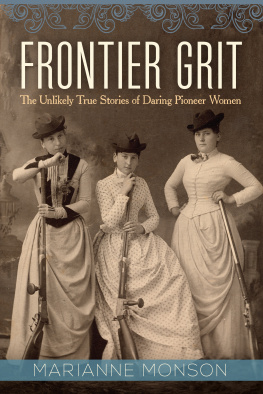The author would like to thank the public libraries of Toronto and Guelph, Ontario; the Public Archives of Canada, the Archives of Ontario, the Hudson's Bay Company Archives; and Shirley Render of Winnipeg, Manitoba.
Introduction
 istory has often overlooked women. Browse through any encyclopedia, and it is obvious that the biographical sketches are overwhelmingly the stories of men. It is as though women, with a few outstanding exceptions, have had relatively little to contribute in the various fields of human endeavor.
istory has often overlooked women. Browse through any encyclopedia, and it is obvious that the biographical sketches are overwhelmingly the stories of men. It is as though women, with a few outstanding exceptions, have had relatively little to contribute in the various fields of human endeavor.
One of the main reasons for this unfortunate situation is that for centuries women were overlooked in history. It was not that women did not have the potential to be great artists, politicians, philosophers, or even soldiers. It was that they were not given the opportunities. For centuries it was generally accepted by men and women alike that women were not capable of doing a man's work. Women were believed to be physically, mentally, and emotionally inferior to men. The father was the head of the household. Wives owed obedience to their husbands. Sons were heirs ahead of daughters. While we, looking back from the 21st century, might condemn all this as terribly unfair, it would be wrong of us to judge our ancestors. Everything in their social environment culture, religion, and philosophy supported the system.
Women were not expected to step beyond the bounds of convention. Their place was where their society told them it was, and that was usually in the home. A lady of the nobility may have enjoyed greater wealth, comfort, and leisure time than a peasant woman, but she was just as much restricted by the moral and social codes of her time.
Of course, there were women who dared to challenge those codes. They did so at the risk of stirring up public anger, creating scandal, estranging their families, even breaking the law. Some did it for personal, even self-centered reasons. Others were motivated by ideals of social justice.
This volume presents the stories of 15 women of Canada who dared in some way to challenge their societies. They ventured into areas previously considered off-limits to females medicine, publishing, the military. They survived harrowing ordeals and courted forbidden romance. Some were Canadian born; others came to Canada from elsewhere. They emerged from different backgrounds, but their common bond was daring to step off the narrow path of custom. Some of these women made mistakes and engaged in criminal activities, for which they paid the price. What they did was not admirable, but like the women whose accomplishments were nobler, they, too, are part of history.

 ne hundred and seventy-five years before Daniel Defoe wrote his famous novel Robinson Crusoe, there was an even more dramatic castaway story unfolding off the coast of Newfoundland. This one was not the result of stormy seas, but of forbidden love.
ne hundred and seventy-five years before Daniel Defoe wrote his famous novel Robinson Crusoe, there was an even more dramatic castaway story unfolding off the coast of Newfoundland. This one was not the result of stormy seas, but of forbidden love.
Marguerite de la Roque de Roberval was a young girl from an old, upper-class French family and was a relative, likely a niece, of Jean Francois de la Rocque de Roberval. Jean Francois was a flamboyant man who was forever running into trouble. He had financial problems and had borrowed heavily from his relatives, perhaps even from young Marguerite. He had sailed as a privateer and seized English ships, angering King Henry VIII of England. And he was a French Protestant at a time when the Roman Catholic majority in France felt Protestants should be hanged. Luckily he was a personal friend of Prince Francois, who would later be king, and that saved him. The French ruler pretended to be angry with Roberval, while all the time keeping him on as a friend at court.
In 1540 Roberval hatched an idea. He decided that he could regain his fortunes and earn immortal glory by establishing a colony in Canada, the territory discovered just a few years earlier by Jacques Cartier. The French were jealous of all the gold and silver that the Spanish were looting from their New World Empire in Mexico and South America, and hoped that Canada might hold similar riches. Cartier had partially navigated the St. Lawrence River and had heard stories from the Natives that convinced him there were precious metals and gems farther up the great river in a place called Saguenay. The French also believed that the St. Lawrence might provide a passage through the New World to the Pacific Ocean a trade route to China. The French king happily bought in to Roberval's idea and made him Lieutenant-General of the country of Canada. Cartier was appointed second-in-command. This did not go over at all well with Cartier. As the discoverer of the new territory, he had expected to lead a colonizing expedition himself. It made him furious to be reduced to the position of mere guide for a courtier. It probably bewildered him, too, that a Protestant such as Roberval (who may have temporarily rejoined the Catholics) should be given the mission of spreading the holy Catholic faith to the Natives.
By May of 1541, Cartier was ready to go with a fleet of five ships, but Roberval had been having difficulties raising funds and recruiting colonists. As a result, Cartier sailed on ahead, agreeing to meet his commander in Canada.
It took another whole year for Roberval to outfit and supply his three ships: the Anne, the Valentine, and the Lechefraye. To make up for a shortage in manpower, he had to drag convicted murderers and thieves out of prisons. It was quite common in those times to use prisoners for the hard, dirty, dangerous jobs that no one else wanted. Sailing off into the Great Unknown on a crowded little ship was certainly one of those jobs. A sailor's life was tough at the best of times, but for those who embarked on these early trans-Atlantic voyages, it was a downright miserable ordeal of hard work, bad food, and the lash.
The voyage was somewhat more bearable for the aristocrats on board the gentlemen who were to be the pillars of society in the new colony and their ladies. One of the women invited to go on the adventure was Roberval's niece, Marguerite. She was a member of his household and, according to reports of the time, Roberval treated her like a daughter. As a rule, girls of the upper class were married off at a very young age. Marguerite was still single, so quite likely she was young, perhaps in her midteens. We know that she was a young woman of some financial means. Marguerite was coseigneuress with Roberval of an estate northeast of Paris and had property of her own at Perigord and Languedoc to the south. She was probably in a position to lend her uncle money for his expedition.















 istory has often overlooked women. Browse through any encyclopedia, and it is obvious that the biographical sketches are overwhelmingly the stories of men. It is as though women, with a few outstanding exceptions, have had relatively little to contribute in the various fields of human endeavor.
istory has often overlooked women. Browse through any encyclopedia, and it is obvious that the biographical sketches are overwhelmingly the stories of men. It is as though women, with a few outstanding exceptions, have had relatively little to contribute in the various fields of human endeavor.

 ne hundred and seventy-five years before Daniel Defoe wrote his famous novel Robinson Crusoe, there was an even more dramatic castaway story unfolding off the coast of Newfoundland. This one was not the result of stormy seas, but of forbidden love.
ne hundred and seventy-five years before Daniel Defoe wrote his famous novel Robinson Crusoe, there was an even more dramatic castaway story unfolding off the coast of Newfoundland. This one was not the result of stormy seas, but of forbidden love.